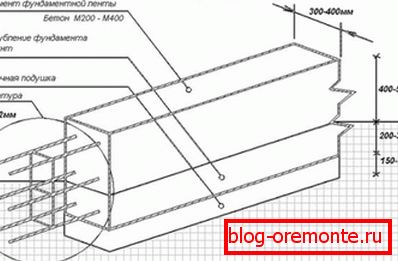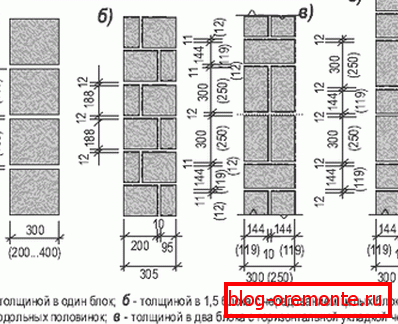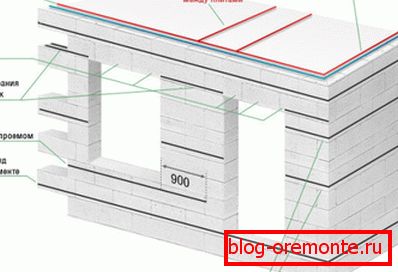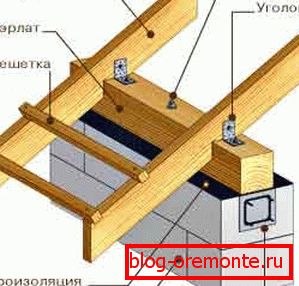How to make a house of claydite blocks yourself
Individual construction involves the construction of residential buildings in their own areas of various materials. A good option is to build a house of claydite-concrete blocks with your own hands, since the economic benefits will be quite noticeable. However, before making a decision, it is recommended to get acquainted with the capabilities of the products.

Preliminary acquaintance with the material
Expanded clay is an artificial stone, created on the basis of a binder - cement, sand and expanded clay in a ratio of 1: 2: 3. In the manufacturing process, as a rule, aggregate granules with a size of 5 mm are used. Thanks to this material, the price of the building is markedly reduced.
Positive aspects of the application
- The proportion of products is rather low, and this makes it possible to abandon the construction of a massive foundation.
- Sufficient strength of the material makes it possible to use it for the construction of bearing walls and walls.
- The relatively low cost of production immediately expands the range of consumers.
- Long service life of elements provides an opportunity to create durable structures.

Negative moments when using
- Due to the high level of porosity, the product may yield to heavy concrete in terms of physical and mechanical characteristics.
- Imperfect geometry and low aesthetic values imply additional surface finish.
- When designing buildings, very accurate calculations must be made, otherwise all sorts of deformations may occur.
Attention! Having considered the pros and cons of a claydite-concrete block house, you can make a final decision on purchasing the material. You can also conduct a comparative analysis with other analogues.
Specifications
The physicomechanical properties of products are regulated by the paragraphs of GOST 6133-99, which also reflect the types and standard sizes. As a rule, elements are made in the form of parallelepipeds of 390x188x190 mm. More detailed information is shown in a special table.
| Product type | Strength mark | Thermal conductivity index | Frost resistance | Density in kg / m³ |
| Full bodied | Ozone | 0,3 | Not standardized | 1300 |
| Double hollow | M50 | 0,35 | F50 | 1050 |
| Three-slot | M50 | 0,35 | Not standardized | 1050 |
| Four gap | M50 | 0,35 | F50 | 1050 |
| Eight-slot | Ozone | 0,35 | F50 | 1150 |
| Full bodied | M100 | 0,3 | F50 | 1100 |
Design of the proposed object
Although modern projects of claydite blocks are quite complex, they can be made independently. It should start with exploration work, which will give an idea of the properties of the soil, which ultimately will allow to choose the type of foundation. Studies should be carried out in late autumn or early spring, when the groundwater is at its maximum.

After receiving the conclusion of the exploration work, you can proceed directly to the planning of the structure. When home designs are created from - out of expanded clay concrete blocks, in order to be economical, they give preference to simpler forms, since they provide an opportunity to reduce costs.
Basic calculations before erection
Immediately before the construction of any object is determined by the amount of material required. In this case, the calculation of the number of lightweight aggregate blocks on the house.
Ниже приводится подробная инструкция, которая поможет произвести все вычисления самостоятельно для жилого строения размерами 6×9 м, высота потолка которого составляет 270 см.

- First, the quadrature of the external walls and partitions is determined. (в нашем случае 2 по 6 м). Для этого площади всех плоскостей суммируются друг с другом. Получается пример: 9×2,7×2+6×2,7×4=48,6+64,8=113,4 кв.м.
- Next you need to know how many square meters will be able to build from one cube of material.. In this case, the division is made by the thickness of the element. It follows from this: 1 / 0.188? 5.31 sq.m.
- At the last stage, the number of cubes needed to build the object is calculated.. The total erection area is divided by the result obtained in the previous paragraph: 113.4 / 5.31 × 21 cubic meters.
Addition! Approximately the calculation of claydite blocks on the house. Determine the number of pieces is not required, because building materials are supplied in units of volume.
Directly building process
Features of the construction of the object are in compliance with the basic principles of laying material. Due to the fact that the elements do not tolerate point loads very well, it is recommended to perform additional reinforcement, which will improve the strength characteristics of the structure.
Creating a ribbon base
For the structure of the individual fragments on the basis of expanded clay is usually arranged the foundation in the form of reinforced concrete strip. He has proven himself on various types of soils.
Depth of depth is determined depending on the freezing of land in a particular region.

- First, the soil is selected around the perimeter of the building and under the bearing partitions for the required distance. The trench width should be at least 30 cm, since the wall thickness will be equal to 20 cm.
- At the bottom of the dug pit lay a layer of sand 150-200 mm. This layer is poured with water, after which it is thoroughly rammed. In the future, it is closed waterproofing material.
- Formwork is made of wooden planks, which is a structure that gives a certain shape to the concrete composition. Its height should not be lower than 40 cm.
- Из стальных прутьев делается армирующая сетка с ячейкой 150×150 мм. Фиксация элементов осуществляется методом сварки или при помощи металлической проволоки.
- M350 concrete is prepared for the foundation, which consists of: 1 share of cement M500, 2 parts of sand and 4 shares of aggregate from gravel. All components are mixed with water.
- Fill should be done within one day. After filling the formwork, the concrete is compacted. To do this, use special vibrating installation.

Note! If for some reason no airways were created in the basement part of the base, then diamond drilling of the holes in the concrete will be required. This will help prevent mold from spreading below.
Laying the main elements
The installation technology of lightweight aggregate segments practically does not differ from conventional masonry. The difference lies in the compositions used for fixation and methods of hardening the concrete structure.
When laying in one block is recommended to think about how to warm the building outside.

- First you need to prepare a cement glue or mortar. In the first case, a dry mixture is used, and in the other - a mixture of a binder with river or quarry sand.
- Masonry begins with the installation of elements at the corners of the structure. An adhesive is immediately applied, after which leveling is performed using a building level.
- Laying continues from one of the corners. The last segment of the series, as a rule, has to be trimmed, for which the Bulgarian is used. When separating a piece, the thickness of the mortar must be considered.
- The second row also begins to form from the corners, but already shifted to the other side. After pre-alignment, the installation of elements is performed on the same principle.
- Every three rows, the structure is reinforced with metal rods, which are placed in the joint between the elements and covered with an adhesive mixture.
- At the last stage, a reinforcing belt is made along the entire perimeter of the building, for which formwork is installed at the top. The steel grid keeps within it and the concrete structure is filled in.

Note! If it is necessary to separate the fragments from the created structure, then the reinforced concrete is cut with diamond circles. This may be required when installing truss feet.
Gable roof device
It is best to protect the inside of the building with a double ramp construction. It is easy to manufacture, therefore it is able to reduce the final cost of a claydite-concrete block house.
In addition, under it you can create a full attic floor.

- Первым делом по периметру укладывается обвязка из брусьев сечением 150×150 мм. Крепление балок к боковым плоскостям строения осуществляется с использованием анкеров.
- Next to the fixed strapping fasten the rafters and are connected in the upper part. For this, small recesses are made from below, after which the crossbars are installed using the corners.
- After installation of all truss legs, the crate is made of a 25 mm thick edging board. The distance between the elements is determined by the roof covering used.

Reference! Gable roofs have two planes that converge in the ridge. On the side is the gable, which is a continuation of the wall. The slope of such structures may be different.
Finishing work
Due to the low aesthetic characteristics of the material, it is recommended to carry out the facing of the erected structure from the inside and from the outside. When finishing from the street, you can create an additional layer of insulation, thereby improving protection against the penetration of cold.
Vinyl siding can be considered an excellent option for facing from the outside, as it lasts a long time and provides an opportunity to warm the building. In addition, the installation of panels is quite possible without the involvement of professionals, and this will save a considerable amount.

Plastering of the claydite-concrete surface is performed from the inside, after which a decorative coating is fixed. The leveling layer also provides the opportunity to improve the thermal insulation of the structure. As a finishing finish can be used any materials that can transform the room.
Final part
The use of blocks on the basis of keramsit concrete makes it possible to build an economical and quite reliable structure for human habitation, especially if finishing is done correctly after the main works. When carrying out the construction process independently, it is recommended to pay special attention to the quality of the masonry, because the duration of the structure's operation will depend on it. The video in this article provides additional information.